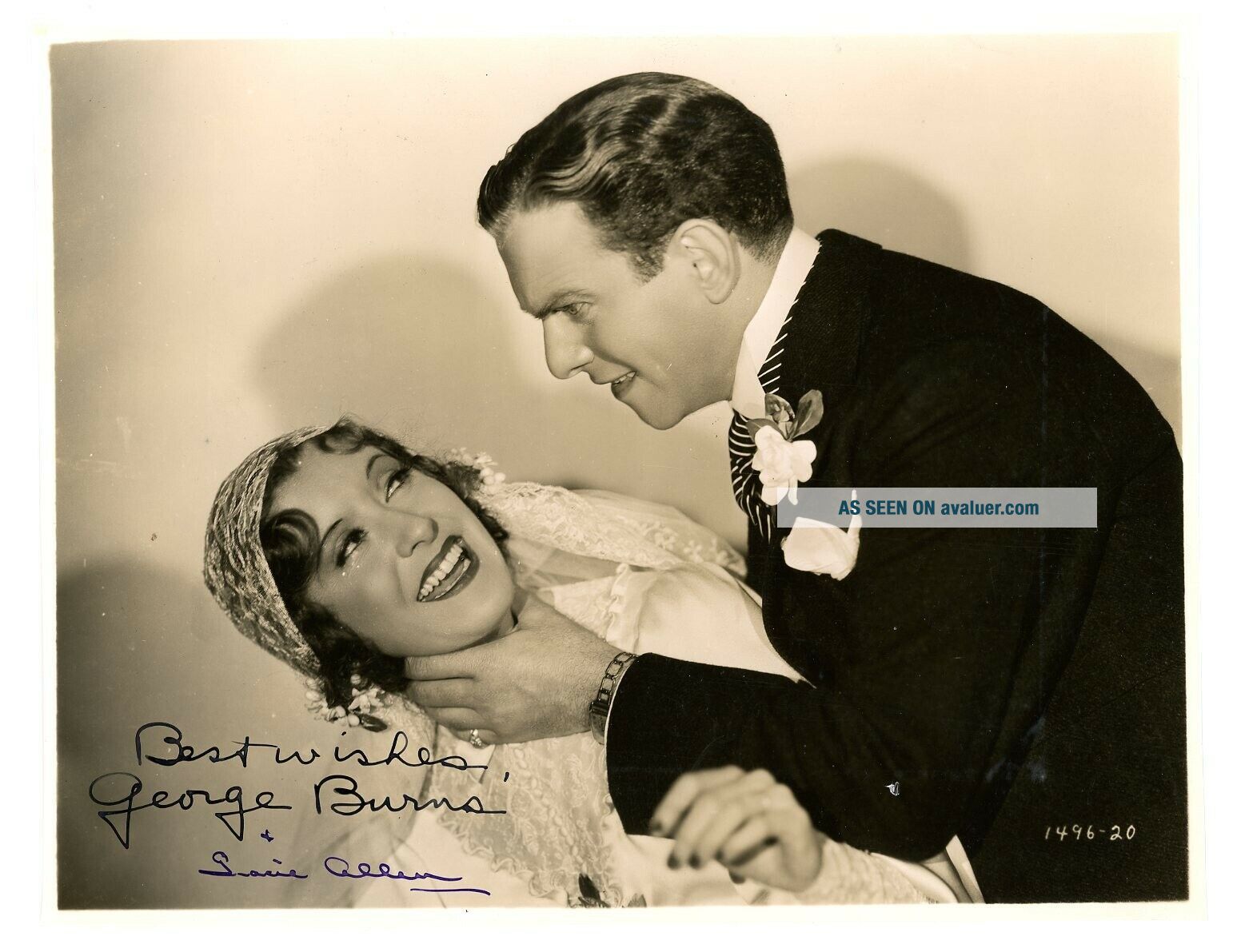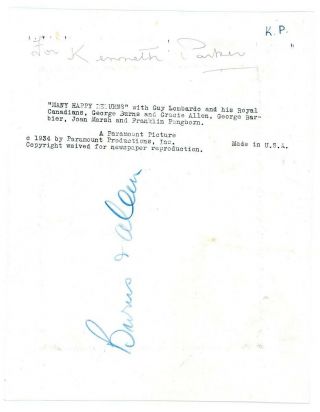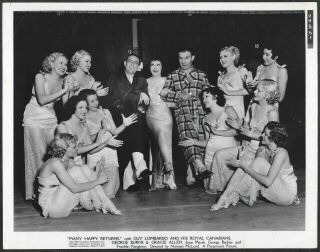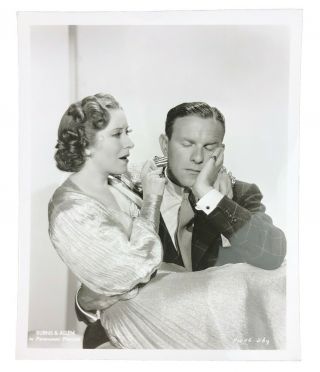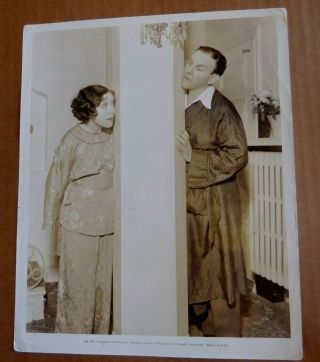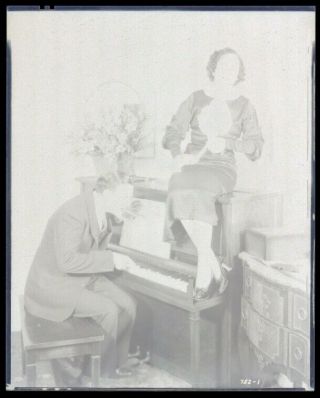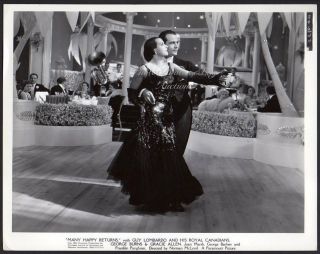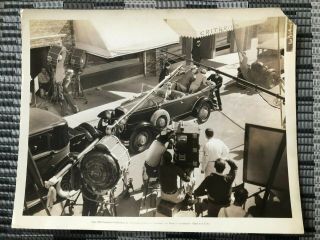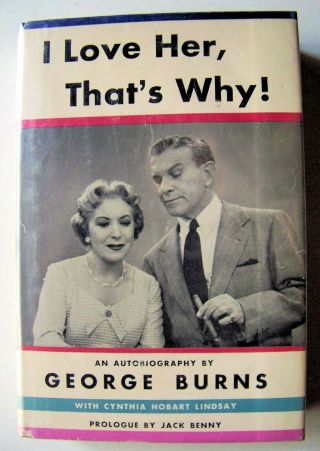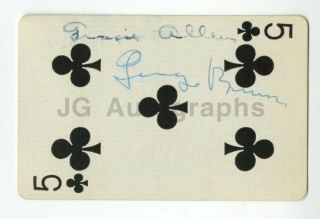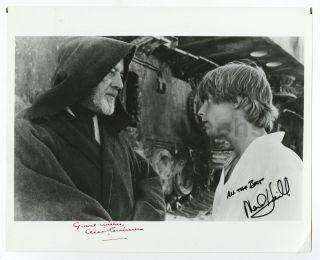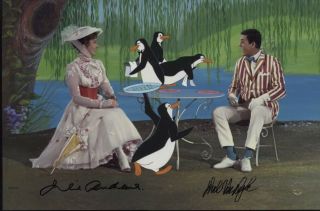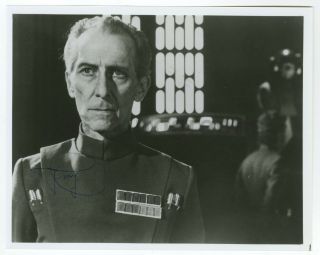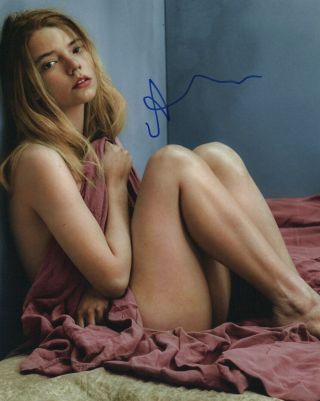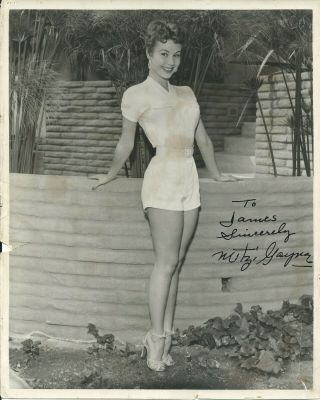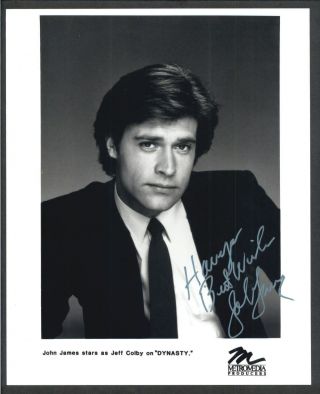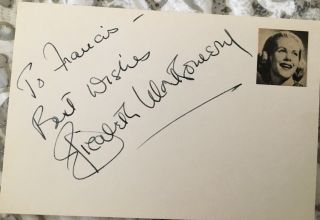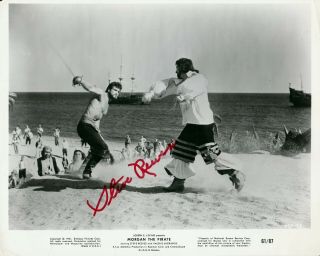GEORGE BURNS GRACIE ALLEN 1934 SIGNED GORGEOUS PHOTOGRAPH AUTOGRAPHED
Item History & Price
DESCRIPTION: MOST GORGEOUS EXAMPLE - HIGHLY RECOMMENDED!! Ac...tor comedians GEORGE BURNS & GRACIE ALLEN vintage original 1934 authentic original signed studio portrait gelatin silver photograph. This image was autographed with a black ink fountain pen.
- This autographed item has beenauthenticated by MY MOVIEMEMORABILIA & MORE, a UACC (Universal Autograph Collectors Club)Registered Dealer (No. RD321), which must abide by the UACC Code of Ethics, allpolicies that the UACC has enacted and must have a good standing as a reputabledealer recommended by long-term UACC dealers. We have years of selling tobuyers internationally with a 100% positive feedback. All of my autographed items have a lifetime money back guarantee ofauthenticity (see Return Policy).
- SIZE: approx. 9 1/2" X 7 1/2" with white border
- TONE: sepia toned B&W
- FINISH: glossy________________________________________________________________________
SHIPPING TERMS
- I ship all items using, what I call, triple protection packing. The photos are inserted into a display bag with a white board, then packed in between two thick packaging boards and lastly wrapped with plastic film for weather protection before being placed into the shipping envelope.
- The shipping cost for U.S. shipments includes USPS "Delivery Confirmation" tracking.- Combined Shipping Discount - only an additional $2.00 to the shipping cost after the first item for any additional items purchased within a period of two weeks.
PAYMENT TERMS
- Please pay within three (3) days of purchase.
- All sales taxes applicable to the City of Los Angeles, State ofCalifornia and the 2019 Marketplace Sales Tax Law in other states shall beapplied.
CUSTOMER SERVICE
I will respond to all inquiries within 24 hours. Please feel free to contact me anytime at 1-310-880-8140 (Pacific Standard Time)
GEORGE BURNS BIO
(January 20, 1896 ? March 9, 1996), born Nathan Birnbaum, was an American comedian, actor, andwriter. His career spannedvaudeville, film, radio, and television, with and without his wife, GracieAllen. His arched eyebrow and cigar smoke punctuation became familiartrademarks for over three quarters of a century. Beginning at the age of 79, George enjoyed a career resurrection as an amiable, beloved and unusuallyactive old comedian, continuing to work until shortly before his death, in 1996, at the age of 100. Nathan Birnbaum was the ninthof twelve children born to Louis and Dorothy (Bluth) Birnbaum in New York City. His fatherwas a substitute cantor at the local synagogue but did not work very often.During the influenza epidemic of 1903, Louiscontracted the flu and died. Nattie (as he was known to his family) startedworking in 1903 after his father's death, shining shoes, running errands, andselling newspapers. When he landed a job as a syrup maker in a local candy shopat the age of seven, Nattie Birnbaum was discovered. Burns quit school in thefourth grade to go into show business full-time. Like many performers of hisgeneration, he tried practically anything he could to entertain, includingtrick roller skating, teaching dance, singing, and adagio dancing in small-timevaudeville. During these years, he began smoking cigars and later in his olderyears was characteristically known as doing shows and puffing on his cigar. Headopted the stage name by which he would be known for the rest of his life. Heclaimed in a few interviews that the idea of the name originated from the factthat two star major league players (George H. Burns and George J. Burns, unrelated) were playing major league baseball at the time. Both men achieved over2000 major league hits and hold some major league records. Burns also wasreported to have taken the name George from his brother and the Burns from theBurns Brothers Coal Company (he used to steal coal from their truck).He normally partnered with agirl, sometimes in an adagio dance routine, sometimes comic patter. Though hehad an apparent flair for comedy, he never quite clicked with any of hispartners, until he met a young Irish Catholic lady in 1923. "And all of asudden, " he said famously in later years "the audience realized I hada talent. They were right. I did have a talent?and I was married to her for 38years." Grace Ethel Cecile RosalieAllen was born into an Irish Catholic show business family and educated at Starof the Sea ConventSchool in San Francisco, Californiain girlhood. She began in vaudeville around 1909, teamed as an Irish-dance act, "The Four Colleens", with her sisters, Bessie, Hazel, and Pearl.She met George Burns and thetwo immediately launched a new partnership, with Gracie playing the role of the"straight man" and George delivering the punchlines as the comedian.Burns knew something was wrong when the audience ignored his jokes butsnickered at Gracie's questions. Burns cannily flipped the act around: After aHoboken, New Jersey performance in which they tested the new style for thefirst time, Burns's hunch proved right. Gracie was the better 'laugh-getter', especially with the "illogical logic" that formed her responses toBurns's prompting comments or questions.Allen's part was known invaudeville as a "Dumb Dora" act, named after a very early film of thesame name that featured a scatterbrained female protagonist, but her"illogical logic" style was several cuts above the Dumb Dorastereotype, as was Burns's understated straight man. The twosome worked the newstyle tirelessly on the road, building a following, as well as a reputation forbeing a reliable "disappointment act" (one that could fill in foranother act on short notice). Burns and Allen were so consistently dependablethat vaudeville bookers elevated them to the more secure "standardact" status, and finally to the vaudevillian's dream: the Palace Theatre in New York.Burns wrote their earlyscripts, but was rarely credited with being such a brilliant comedy writer. Hecontinued to write the act through vaudeville, films, radio, and, finally, television, first by himself, then with his brother Willie and a team ofwriters. The entire concept of the Burns and Allen characters, however, was onecreated and developed by Burns.As the team toured invaudeville, Burns found himself falling in love with Allen, who was engaged toanother performer at the time. After several attempts to win her over, hefinally succeeded (by accident) after making her cry at a Christmas party. Shetold a friend that "if George meant enough to her to make her cry she mustbe in love with him".They were married in Cleveland, Ohioon January 7, 1926, somewhat daring for those times, considering Burns's Jewish and Allen's Irish Catholic upbringing. Theyadopted their daughter, Sandra, in 1934 and son, Ronnie, in 1935. (For herpart, Allen also endeared herself to her in-laws by adopting his mother'sfavorite phrase, used whenever the older woman needed to bring her son backdown to earth: "Nattie, you're such a schmuck, " using a diminutive ofhis given name. When Burns's mother died, Allen comforted her grief-strickenhusband with the same phrase.)In later years Burns admittedthat, following an argument over a pricey silver table centerpiece Allenwanted, he had a very brief affair with a Las Vegas showgirl. Stricken by guilt, he phoned JackBenny and told him about the indiscretion. However, Allen overheard theconversation and Burns quietly bought the expensive centerpiece and nothingmore was said. Years later, he discovered that Allen had told one of herfriends about the episode finishing with "You know, I really wish Georgewould cheat on me again. I could use a new centerpiece."Getting a start in motion pictures with a series of comic short films, their feature credits in the mid- to late-1930s included The Big Broadcast;International House (1933), Six of aKind (1934), The Big Broadcast of 1936, The Big Broadcast of 1937, A Damsel in DistressCollege Swing (1938), in which Bob Hope made one ofhis early film appearances. (1937) in which they danced step for stepwith Fred Astaire Burns and Allen wereindirectly responsible for the Bob Hope and Bing Crosby series of"Road" pictures. In 1938, William LeBaron, producer and managingdirector at Paramount, had a script prepared by Don Hartman and Frank Butler. It was to star Burns andAllen with a young crooner named Bing Crosby. The story did not seem to fit thecomedy team's style, so LeBaron ordered Hartman and Butler to rewrite the script to fit two maleco-stars: Hope and Crosby. The script was titled Road to Singapore andit made motion picture history when it was released in 1940.Burns and Allen first made itto radio as the comedy relief for bandleader Guy Lombardo, which did not alwayssit well with Lombardo's home audience. In his later memoir, The Third TimeAround, Burns revealed a college fraternity's protest letter, complainingthat they resented their weekly dance parties with their girl friends to"Thirty Minutes of the Sweetest Music This Side of Heaven" had to bebroken into by the droll vaudeville team.In time, though, Burns andAllen found their own show and radio audience, first airing on February 15, 1932 and concentrating on their classic stage routines plus sketch comedy inwhich the Burns and Allen style was woven into different little scenes, notunlike the short films they made in Hollywood.They were also good for a clever publicity stunt, none more so than the huntfor Gracie's missing brother, a hunt that included Gracie turning up on otherradio shows searching for him as well.The couple was portrayed atfirst as younger singles, with Allen the object of both Burns's and other castmembers affections. Most notably, bandleaders Ray Noble (known for his phrase, "Gracie, this is the first time we've ever been alone") and ArtieShaw played "love" interests to Gracie. In addition, singer TonyMartin played an unwilling love interest of Gracie's, in which Gracie"sexually harassed" him, by threatening to fire him if the romanticinterest wasn't returned. In time, however, due to slipping ratings and thedifficulty of being portrayed as singles in light of the audience's closefamiliarity with their real-life marriage, the show adapted in 1940 to presentthem as the married couple they actually were. For a time, Burns and Allen hada rather distinguished and popular musical director: Artie Shaw, who alsoappeared as a character in some of the show's sketches. A somewhat differentGracie also marked this era, as the Gracie character could often found to bemean to George.George Your mother cut my face out of thepicture.
Gracie Oh Georgeyou're being sensitive.
George I am not!Look at my face! What happened to it?
Gracie I don'tknow; it looks like you fell on it.OrCensus Taker What do you make?
Gracie I makecookies and aprons and knit sweaters.
Census Taker No, Imean what do you earn?
Gracie George'ssalary.As this format grew staleover the years, Burns and his fellow writers redeveloped the show as a situation comedy in the fall of 1941. The reformatfocused on the couple's married life and life among various friends, includingElvia Allman as "Tootsie Sagwell, " a man-hungry spinster in love withBill Goodwin, and neighbors, until the characters of Harry and Blanche Mortonentered the picture to stay. Like The Jack Benny Program, the new GeorgeBurns & Gracie Allen Show portrayed George and Gracie as entertainerswith their own weekly radio show. Goodwin remained, his character as"girl-crazy" as ever, and the music was now handled by MeredithWillson (later to be better known for composing the Broadway musical TheMusic Man). Willson also played himself on the show as a naive, friendly, girl-shy fellow. The new format's success made it one of the few classic radiocomedies to completely re-invent itself and regain major fame.The supporting cast duringthis phase included Mel Blanc as the melancholy, ironically named "HappyPostman" (his catchphrase was "Remember, keep smiling!"); BeaBenaderet (later Cousin Pearl in The Beverly Hillbillies, Kate Bradleyin Petticoat Junction and the voice of Betty Rubble in TheFlintstones) and Hal March (later more famous as the host of The $64, 000Question) as neighbors Blanche and Harry Morton; and the various members ofGracie's ladies' club, the Beverly Hills Uplift Society. One running gag duringthis period, stretching into the television era, was Burns's questionablesinging voice, as Gracie lovingly referred to her husband as "SugarThroat." The show received and maintained a top ten rating for the rest ofits radio life.The couple took the show toCBS in the fall of 1949, after having spent virtually their entire radio careerto date on NBC. Their good friend Jack Benny reached a negotiating impasse withNBC over the corporation he set up ("Amusement Enterprises") topackage his show, the better to put more of his earnings on a capital-gainsbasis and avoid the 80 percent taxes slapped on very high earners in the WorldWar II period. When CBS executive William S. Paley convinced Benny to move toCBS (Paley, among other things, impressed Benny with his attitude that theperformers make the network, not the other way around as NBC chief DavidSarnoff reputedly believed), Benny in turn convinced several NBCstars to join him, including Burns and Allen. Thus did CBS reap the benefitswhen Burns On television, TheGeorge Burns & Gracie Allen Showput faces to the radio characters audiences had come to love. A number ofsignificant changes were seen in the show: A parade of actors portrayed Harry Morton: Hal March, The Life Of Riley alumnus John Brown, veteran movie and television character actor Fred Clark, and future Mister Ed co-star Larry Keating. Burns often broke the fourth wall, and chatted with the home audience, telling understated jokes and commenting wryly about what show characters were doing or undoing. In later shows, he would actually turn on a television and watch what the other characters were up to when he was off camera, then returned to foil the plot. When announcer Bill Goodwin left after the first season, Burns hired veteran radio announcer Harry Von Zell to succeed him. Von Zell was cast as the good-natured, easily-confused Burns and Allen announcer and buddy. He also became one of the show's running gags, when his involvement in Gracie's harebrained ideas would get him fired at least once a week by Burns. The first shows were simply a copy of the radio format, complete with lengthy and integrated commercials for sponsor Carnation Evaporated Milk by Goodwin. However, what worked well on radio appeared forced and plodding on television. The show was changed into the now-standard situation comedy format, with the commercials distinct from the plot. Midway through the run of the television show the Burns' two adopted children, Sandra and Ronald, began to make appearances: Sandy as an occasional drama school classmate of Ronnie, and Ronnie himself as George and Gracie's son, who held his parents' comedy style in befuddled contempt and deemed it unsuitable to the "serious" drama student. In one episode, Ronnie and Sandy, in a plot centered around their school's staging a vaudeville-style show to raise money, performed a remarkable impersonation of their famous parents' stage and radio comedy routines.Burns and Allen also took acue from Lucille Ball and Desi Arnaz's Desilu Productions and formed a companyof their own, McCadden Corporation (named after the street on which Burns'sbrother lived), headquartered on the General Service Studio lot in the heart ofHollywood, and set up to film television shows and commercials. Besides theirown hit show (which made the transition from a bi-weekly live series to aweekly filmed version in the fall of 1952), the couple's company produced suchtelevision series as The Bob Cummings Show (subsequently syndicated andrerun as Love That Bob); The People's Choice, starring JackieCooper; Mona McClusky, starring Juliet Prowse; and Mister Ed, starring Alan Young and a talented "talking" horse. Several of theirgood friend Jack Benny's 1953-55 filmed episodes were also produced by McCaddenfor CBS.The George Burns &Gracie Allen Show ranon CBS Television from 1950 through 1958, when Burns at last consented toAllen's retirement. The onset of heart trouble in the early 1950s had left herexhausted from full-time work and she had been anxious to stop but couldn't sayno to Burns.Burns attempted to continuethe show (for new sponsor Colgate-Palmolive on NBC), but without Allen toprovide the classic Gracie-isms, the show expired after a year.Burns subsequently created Wendyand Me, a situation comedy in which he co-starred with Connie Stevens, RonHarper, and J. Pat O'Malley. Burns acted primarily as the narrator, andsecondarily as the advisor to Stevens' Gracie-like character. The first episodeinvolved the middle-aged Burns watching with amusement the activities of hisyoung upstairs neighbor on his television set, apparently via hidden cameras, then breaking the fourth wall and commenting directly to viewers. The seriesonly lasted a year. In a promotion, Burns had joked that "Connie Stevensplays Wendy, and I play 'me'."After fighting a long battlewith heart disease, Gracie Allen suffered a fatal heart attack in her home onAugust 27, 1964 at the age of 69. She was entombed in a mausoleum at ForestLawn Memorial Park Cemetery. In his second book, They Still Love Me inAltoona, Burns wrote that he found it impossible to sleep after her deathuntil he decided to sleep in the bed she used during her illness. He also visitedher grave once a month, professing to talk to her about whatever he was doingat the time ? including, he said, trying to decide whether he really shouldaccept the Sunshine Boys role Jack Benny had to abandon because of hisown failing health. He visited the tomb with Ed Bradley during a 60 Minutesinterview on November 6, 1988.After Gracie's death Georgeimmersed himself in work. McCadden Productions co-produced the televisionseries No Time for Sergeants, based on the hit Broadway play; Georgealso produced Juliet Prowse's 1965-'66 NBC situation comedy, Mona McCluskey.At the same time, he toured the U.S.playing nightclub and theater engagements with such diverse partners as CarolChanning, Dorothy Provine, Jane Russell, Connie Haines, and BerleDavis. He also performed a series of solo concerts, playing universitycampuses, New York'sPhilharmonic Hall and winding up a successful season at Carnegie Hall, where hewowed a capacity audience with his show-stopping songs, dances, and jokes.In 1974, Jack Benny signed toplay one of the lead roles in the film version of Neil Simon's The SunshineBoys (Red Skelton was originally the other). Benny's health had begun tofail, however, and he advised his manager Irving Fein to let longtime friendBurns fill in for him on a series of nightclub dates to which Benny hadcommitted around the U.S.Burns, who enjoyed working, accepted the job. As he recalled years later:"Thehappiest people I know are the ones that are still working. The saddest are theones who are retired. Very few performers retire on their own. It's usuallybecause no one wants them. Six years ago Sinatra announced his retirement. He'sstill working."But Benny was never able towork on The Sunshine Boys, as he'd been diagnosed with pancreatic cancer, from which he died soon thereafter (December 26, 1974). Burns, heartbroken, said that the only time he ever wept in his life other than Gracie's death waswhen Benny died. He was chosen to give one of the eulogies at the funeral andsaid, "Jack was someone special to all of you but he was so special tome?I cannot imagine my life without Jack Benny and I will miss him so verymuch."[citation needed] Burns then broke down and had tobe helped to his seat. People who knew George said that he never could reallycome to terms with his beloved friend's death.Burns replaced Benny in thefilm as well as the club tour, a move that turned out to be one of the biggestbreaks of his career; his wise performance as faded vaudevillian Al Lewisearned him an Academy Award for Best Supporting Actor, and secured his careerresurgence for good. At the age of 80, Burns was the oldest Oscar winner in thehistory of the Academy Awards, a record thatwould remain until Jessica Tandy won an Oscar for Driving Miss Daisy in1989.In 1977, Burns made anotherhit film, Oh, God!, playing the omnipotent title role opposite singerJohn Denver as an earnest but befuddled supermarket manager, whom God picks atrandom to revive His message. The image of Burns in a sailor's cap and lightspringtime jacket as the droll Almighty influenced his subsequent comedic work, as well as that of other comedians. At a celebrity roast in his honor, DeanMartin adapted a Burns crack: "When George was growing up, the Top Tenwere the Ten Commandments."Burns appeared in thischaracter along with Vanessa Williams on the September 1984 cover of Penthousemagazine, the issue which contained the infamous nude photos of Williams, aswell as the first appearance of underage pornographic film star Nora Kuzma, better known to the world as Traci Lords.A blurb on the cover even announced "Oh God, she's nude!"Oh, God! inspired two sequels Oh, God! BookII (in which the Almighty engages a precocious schoolgirl (Louanne Sirota)to spread the word) and Oh, God! You Devil?in which Burns played a dualrole as God and the Devil, with the soul of a would-be songwriter (Ted Wass) atstake.Burns also provided the voiceof God in John Denver's TV special Montana Christmas Skies.After guest starring on TheMuppet Show, Burns appeared in Sgt. Pepper's Lonely Hearts Club Band, the film based on the Beatles' album of the same name.Burns did a movie with ArtCarney in 1979 called Going in Style.Burns continued to work wellinto his nineties, writing a number of books and appearing in television andfilms. One of his last films was 18 Again!, based on his half-novelty, country music based hit single, "I Wish I Was 18 Again." In thisfilm, he played a self-made millionaire industrialist who switched bodies withhis awkward, artistic, eighteen-year-old grandson (played by CharlieSchlatter).His last feature film rolewas the cameo role of Milt Lackey, a 100 year old stand-up comedian, in thecomedy mystery Radioland Murders.Burns was a bestsellingauthor who wrote a total of 10 books: Burns, George; Hobart Lindsay, Cynthia (1955). I Love Her, That's Why. Simon and Schuster. Burns, George (1976). Living it up: Or, They Still Love Me in Altoona!. Putnam. ISBN 978-0399116360. Burns, George (1980). The Third Time Around. Putnam. ISBN 978-0399121692. Burns, George (1983). How To Live To Be 100 - Or More - The Ultimate Diet, Sex and Exercise Book. Robson Books. ISBN 978-0399129391. Burns, George (1984). Dr. Burns' Prescription for Happiness: Buy Two Books and Call Me in the Morning. Putnam. Burns, George (1985). Dear George. Putnam. Burns, George (1988). Gracie : A Love Story. Putnam. ISBN 0399133844. Burns, George; Fisher, David (1989). All My Best Friends. Putnam. ISBN 0399134832. Burns, George; Goldman, Hal (1991). Wisdom of the 90's. Putnam. Burns, George (1996). 100 Years 100 Stories. Putnam. ISBN 978-0399141799. When Burns turned 90 in 1986, the city of Los Angeles, Californiarenamed the northern end of Hamel Road "George Burns Road."Beverly Centermall. City regulations prohibited naming a city street after a livingperson, but an exception was made for Burns. In celebration of Burns's 99thbirthday in 1995, Los Angeles, California renamed the easternend of Alden Drive"Gracie Allen Drive."Burns was present at the unveiling ceremony where he quipped, "It's goodto be here at the corner of Burns & Allen. At my age, it's good to beanywhere!" George Burns Roadand Gracie Allen Drivecross just a few blocks west of the George Burns' patter in hisnightclub routine poked humor at his age. Burns would say, "I was bornwhen Grover Cleveland was President." The girl replied, "I knowhim?he managed a baseball team." Burns would say, "I will now sing amodern patriotic song, " singing, "I'll be waitin' for you Bill whenyou get back from San Juan Hill; because BillMcKinley sent you on your way." By this time, Burns fans knew of PresidentMcKinley, President Cleveland and the Spanish-AmericanWar only from history books.Burns's stage persona in hisfinal phase of professional life was that of an amorous senior citizen, whichbecame a running gag for the rest of his career. In 1988, he received theKennedy Center Honors and had booked himself to play the London Palladium and Caesars Palace for his 100th birthday.In July 1994, Burns fell inhis bathtub and had to undergo surgery to remove fluid that had collected onhis brain. His health began to decline afterward. All performances celebratinghis 100th birthday were canceled. In December 1995, Burns was well enough toattend a Christmas party hosted by FrankSinatra, where he reportedly caught the flu, which weakened him further. OnJanuary 20, 1996, he celebrated his 100th birthday, but was no longer mobileenough to perform and instead spent the evening at home.On March 9, 1996, justforty-nine days after his milestone birthday, Burns died in his Beverly Hillshome of cardiac arrest. His funeral was held three days later at the Wee Kirko' the Heather church in Forest Lawn Memorial Park Cemetery, Glendale. George Burns was buried in his bestdark blue suit, light blue shirt and red tie along with three cigars in hispocket, his toupee, his watch that Gracie had given him, his ring, and in hispocket, his keys and his wallet with 10 $100 bills, a five and three ones.As much as he looked forwardto reaching the age of 100, Burns also stated that he looked forward to death, saying that the day he died he would be with Gracie again in heaven. Upon beinginterred with Gracie, the crypt's marker was changed to, "Gracie Allen& George Burns?Together Again." George had said that he wanted Gracieto have top billing. Burns and Allen were the subjects of Rupert Holmes's play Say Goodnight, Gracie. In the movie Star Trek IV: The Voyage Home, the two humpback whales are named George and Gracie after Burns and Allen. Hooters restaurants had signs that prior to George's death read "We even card George Burns, " and following his death were changed to read "We even carded George Burns." The episode "The Deep End" of Robot Chicken features a parody of the movie Kill Bill entitled Kill Bunny with George Burns replacing Pai Mei. The Simpsons referenced Burns in the Season 5 episode titled "Rosebud". In the show, Burns is the younger brother of Montgomery Burns. The character of Mr. Burns, as a kid, leaves his family to live with a rich man (who is actually his paternal grandfather). His father makes the comment, "Oh well. At least we still have his little brother George." The camera flashes to a kid-sized George Burns, who sings a line in his style and then says, "Trust me, it'll be funny when I'm an old man." In South Park: Bigger, Longer & Uncut, George Burns appears briefly when Kenny goes to Hell. Along with Adolf Hitler and Mahatma Gandhi, he is a ghost who talks to Kenny, and is heard saying, "Hey, fuckface, you seen Gracie?". In an episode of Boy Meets World, Corey Mathews claims an old educational puberty film starred George Burns. In the film For the Boys, the characters played by Bette Midler and James Caan talk about how their comedy act will be "bigger than Burns and Allen, bigger than Hope and Crosby". In an episode of Mad About You, Paul Reiser's character is working on a documentary on the history of television. In a scene he is reviewing classic television shows, and the viewer can hear Gracie saying, "Well, if we were married they'd call me Mrs. Burns." In Eminem's duel rap song Guilty Conscience, there is a reference to George Burns, "Think about it before you walk in the door first; Look at the store clerk, she's older than George Burns" In a Far Side cartoon, a futuristic city is shown, with flying cars, a theater billboard stating "TONIGHT ONLY, GEORGE BURNS".Filmography Features The Big Broadcast (1932) International House (1933) College Humor (1933) Six of a Kind (1934) We're Not Dressing (1934) Many Happy Returns (1934) Love in Bloom (1935) Here Comes Cookie (1935) The Big Broadcast of 1936 (1935) College Holiday (1936) A Damsel in Distress (1937) College Swing (1938) Honolulu (1939) The Solid Gold Cadillac (1956) (narrator) The Sunshine Boys (1975) Oh, God! (1977) Movie Movie (1978) Sgt. Pepper's Lonely Hearts Club Band (1978) Just You and Me, Kid (1979) Going in Style (1979) Oh, God! Book II (1980) Oh, God! You Devil (1984) 18 Again! (1988) A Century of Cinema (1994) (documentary) Radioland Murders (1994) Short Subjects Lambchops (1929) Fit to Be Tied (1930) Pulling a Bone (1931) The Antique Shop (1931) Once Over, Light (1931) 100% Service (1931) Oh, My Operation (1932) The Babbling Book (1932) Your Hat (1932) Let's Dance (1933) Hollywood on Parade No. A-9 (1933) Walking the Baby (1933) Screen Snapshots: Famous Fathers and Sons (1946) Screen Snapshots: Hollywood Grows Up (1954) Screen Snapshots: Hollywood Beauty (1955) All About People (1967) (narrator) A Look at the World of Soylent Green (1973) The Lion Roars Again (1975) TVseries The George Burns and Gracie Allen Show 1950?1958; CBSBroadcast liveevery other week for the first two seasons, 26 episodes per year. Starting inthe third season, all episodes were filmed and broadcast weekly, 40 episodesper year. A total of 291 episodes were created. The George Burns Show 1958?1959; NBCAnunsuccessful attempt to continue the format of The George Burns and GracieAllen Show without Gracie, the rest of the cast intact. Wendy and Me 1964?1965; NBCGeorge playsnarrator in this short-lived series, just as he had in The George Burns andGracie Allen Show, but with far less on-screen time, as the focus is on ayoung couple played by Connie Stevens and Ron Harper. Stevens is, essentially, playing a version of Gracie's character. George Burns Comedy Week 1985; CBSAnothershort-lived series, a weekly comedy anthology program whose only connectingthread was George's presence as host. He does not appear in any of the actualstorylines. He was 89 years old when the series was produced. (courtesy of Wikipedia)
inkfrog terapeak



